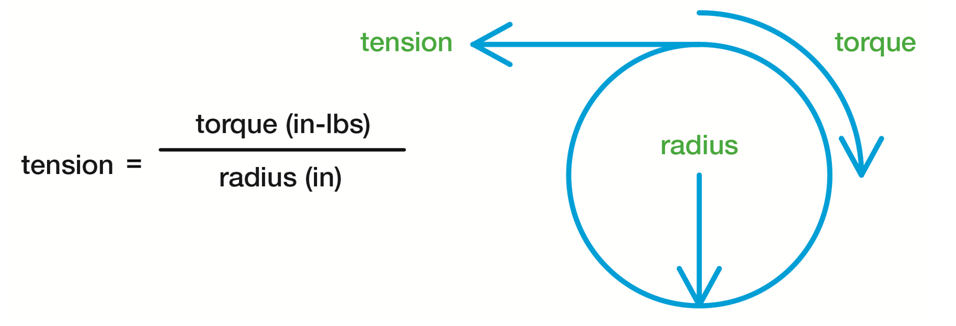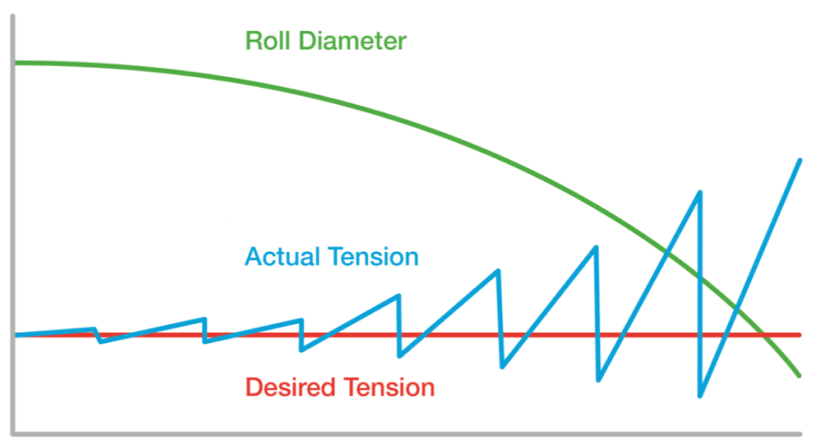Overview
Open-loop tension controls tend to be simple, inexpensive and can be very effective for providing constant and consistent unwind tension for your process. While we can mostly agree that a closed-loop tension control system provides a more accurate and consistent form of web tension control, there may be other mitigating factors that favor an open-loop type of system for a particular process. Some of these factors include: overall cost and complexity of installing a closed-loop system, limited machine real estate available for such installations, perceived tension tolerance (ability for the material or process to withstand significant variability around the optimum “set point” tension), or process restrictions and/or limitations, to name but a few.
Typical open-loop tension control systems rely 100% on roll diameter (indirect) feedback to control tension. Products such as ultrasonic sensors, lasers, or proximity sensors are used to measure or calculate changes in the roll’s diameter and relay this information to the tension controller. The controller monitors and/or calculates the roll diameter as it changes during the unwinding process, and automatically reduces the torque of the brake proportionally. As the T=Tq/R formula dictates (see figure 1), this will maintain constant web tension from full roll to core.
Figure 1

Because there is no direct web feedback in order to actually monitor and regulate control (hence the term open loop control), the accuracy of the control system depends on the accuracy of the diameter calculation and the linearity of the torque device attached to the roll of material.
Torque devices include brakes, motors, or drives that should deliver linear and responsive torque. Montalvo’s highly responsive and linear brakes deliver smooth, reliable torque throughout the entire production run and is one of the reasons we have been a sought-after source for high-quality open-loop systems.
In a well-maintained system, with a very linear torque device, open-loop tension control can provide tension accuracy within 10% of desired setpoint (compared to 1-2% in closed loop systems). We refer to this as the tension tolerance of your material and/or process. If the system degrades mechanically, or the linearity of the torque device is sub-standard or changes over time, this tension accuracy will be compromised.
If your materials or process can withstand this level of tension variability, then an open loop tension control system may be a good option for you. It is certainly a far cry better than utilizing a manual control system, which relies on the operators to make regular and consistent changes to the torque level of the brake as the roll diameter changes. You can probably guess what the tension variability will be under manual control! (see figure 2)
Figure 2: Typical results of Manual Control.
*The goal of any control system is for Actual Tension to match Desired Tension

Because tension is being controlled proportionally with no direct web feedback, another highly dependent quality factor of an open-loop system is the skill and experience of the operator to ensure that the starting web tension (controller TRIM level/Starting Brake Output level) is correct for the material and process. If you run a variety of materials, and/or have several shifts and have different operators, it can be challenging to obtain the same results consistently.
To recap; in order to have a high quality open loop tension control system, you must have a high quality diameter calculation device, a linear, smooth torque device, an experienced operator, and a quality tension controller that can bring everything together.
New Technological Developments
However, new open loop tension control technology has improved tension tolerances to ~5% (as mentioned previously currently open loop tolerances are ~10% compared to closed loop ~1-2%) while making it easier for operators and adding quality and performance to open loop processes.
For the first time ever in an open loop control system, Montalvo’s Torque Sensing Control System (TSC™) provides a precise, reliable tension reference that operators can use to ensure high quality, consistent production runs.
Montalvo’s TSC™ system adds our new Torque Sensor (TS) to Montalvo’s V Series and CS Series brakes to provide an accurate, calibrated measurement of the torque being delivered by the brake at any given time (see Figure 3). Since the formula T=Tq/R is true, and since we now know the brake torque (via the TS) and we know the roll radius, we now know exactly what the web tension is.
Figure 3: TSC™ components – U4 Tension Controller, TS Torque Sensor, V Series Brake
Operators can now easily and consistently set and monitor the actual web tension from start to finish.
Combined with the responsive, linear torque delivery of Montalvo Brakes; tension verification, available for the first time ever in open-loop tension control systems via the TS Torque Sensor, creates a highly precise, consistent, and high performance system.
Other system advantages include that the system can be utilized on applications where it is impractical to install a typical closed loop system due to space restrictions, technical complexity, or cost considerations. It also allows for an accurate tension reference on systems where it would be impossible to fit traditional load cells, such as on machines where the web enters the process directly from the unwind.
The TSC™ is a total tension control solution that delivers performance, convenience, and productivity. Simple, compact and easy to install and operate, the TSC™ is the latest innovation in open-loop tension control. The TSC™ features patent-pending technology.
The TSC™ is ideal for applications where…
- The machine cannot accommodate load cells or retrofits (space limitations, costs, etc.).
- There is no defined web path, multiple web paths, or web is traveling directly from unwind roll into the process.
- The web cannot be contacted after unwind by rollers or requires minimal roller contact (coating, films, foils, etc.).
- Multiple unwind stands that each require cost effective, simple control, and a simple web path (sheeters, laminators).
- Multiple web paths off the unwind, with no defined or consistent fixed wrap angle for a traditional load cell application
- Existing open-loop system, but want to improve consistency and quality of your production.
- Utilizing a PLC or similar system and want to control torque with minimal modification and effort.
Additional features include:
- Easy Installation, Set Up & Operation
- Reduces Machine Build Cost
- Easily Upgrade Existing Machines
- Smooth, Precise, Repeatable Tension Control from Full Roll to Core
- Compact, Space Saving Tension Control Package
- Performance Driven, High Quality Components


